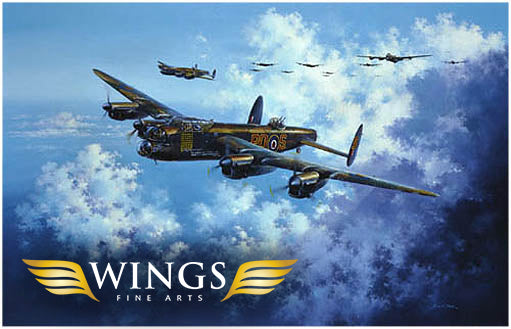Return of the Pathfinders by Anthony Saunders - Aviation Art
- Variant: Limited Edition
- In Stock: 0
- Brand: Wings Fine Arts
- Collection: The RAF Mosquito Bomber
Product Specs
"Return of the Pathfinders"
By Anthony Saunders
Special Gift For Wings Customers!
Get FOUR (4) Mosquito Pilot Profiles Included FREE with Your Purchase.

Never had there been an aircraft like the de Havilland Mosquito; constructed almost entirely of wood with two Merlin engines bolted under each wing it could outrun any other piston-engine fighter in the world. Only when the Luftwaffe’s Me262 jet came on the scene did the enemy have anything of such speed but, unlike the Me262, the Mosquito – nicknamed the ‘Wooden Wonder’ – was perhaps the most versatile aircraft of World War II.
Allied squadrons operated Mosquitos in a huge number of roles including both day and night-bombers, night-fighter, as a ship-buster with Coastal Command, bomber support, photo-reconnaissance and, thanks to its speed and manoeuvrability as one of the finest intruders of the war. Mosquitos carried out some of the most dangerous and daring low-level pinpoint precision strikes ever seen and, of course, as part of the RAF’s elite Pathfinder force.
Formed in 1942 and led by the inspirational Don Bennett, perhaps the finest navigator in aviation history who became the youngest Air Vice-Marshal in the RAF, the Pathfinders were Bomber Command’s specialist target-marking squadrons who, flying ahead of the main bomber force, located and identified their assigned targets with flares.
Anthony Saunders’ atmospheric painting Return of the Pathfinders depicts the Pathfinder Mosquitos of 139 (Jamaica) Squadron, a unit that had joined Bomber Command’s No 8 (Pathfinder) Group in July 1943. Anthony skilfully conjures up the mood as dawn breaks over acrisp, icy landscape in a burst of colour that illuminates the Mosquitos as they follow the course of the River Great Ouse on their return to RAF Upwood after a long overnight trip to Germany in early 1944. During a period that began on the night of 20 / 21st February 1944 this particular squadron undertook a series of 36 consecutive night attacks on Berlin.
Overall size: 24¼" x 30¼"
THE EDITIONS:
- Limited Edition: Signed by four Mosquito aircrew. ~ 325 prints ($165)
- Artist Proof: As above ~ 25 prints ($275)
- Remarque: As above ~ 15 prints ($495)
- Double Remarque: As above ~ 10 prints ($795)
THE SIGNATURES
- Fg Off Ken Oatley - Navigator with 627 Sqn Pathfinders
- Flt Lt George Dunn DFC MiD - Pilot with 608 Sqn Pathfinders
- Flt Lt John Trotman DFC* - Pilot with 692 Sqn Pathfinders
- Flt Lt Des Curtis DFC - Navigator with 248 Sqn Banff Strike Wing






